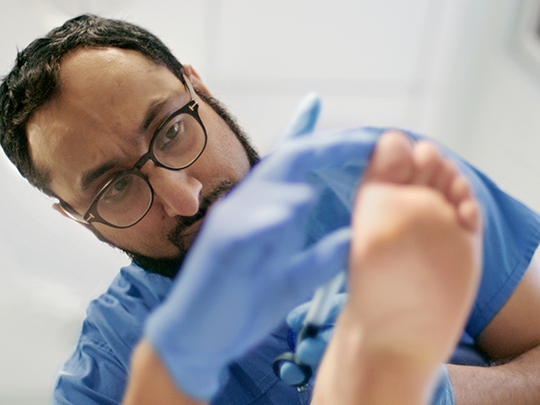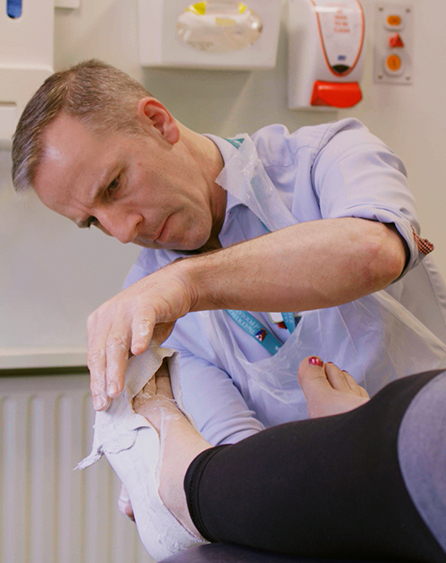
Ismail, Podiatrist
Podiatrist
A Podiatrist is a vital and varied role within the NHS. You’ll help people deal with a range of mobility issues, relieve pain and treat infections of the feet and lower legs. You’ll work in all kinds of places, with all kinds of people, from athletes and dancers to children or older people.
| Salary range | £24,000+ | |
| Hours | 37.5 hours a week | |
| Pattern | Regular hours, with possible evening and weekend work for self-employed Podiatrists |
![]() Podiatrist is a shortage specialism. Courses at English universities attract an additional £1,000 per year to study on top of the minimum £5,000 study grant. Learn more
Podiatrist is a shortage specialism. Courses at English universities attract an additional £1,000 per year to study on top of the minimum £5,000 study grant. Learn more
Role details
A Podiatrist specialises in feet and lower limbs. You’ll deal directly with patients, even while studying, and help to improve their mobility and quality of life.
Podiatrists work in a variety of places, from hospitals and clinics, to patients’ homes and private practices.
You’ll also work with people from all walks of life, and could find yourself helping anyone from children to older people, dancers to professional athletes.
You’ll diagnose and treat patients, and advise other healthcare professionals as part of a wider, integrated team comprising of physiotherapists, dieticians, GPs, and more.
Qualities needed

Interpersonal skills: able to make people feel relaxed.

Critical thinking to accurately diagnose conditions and recommend treatment.

Happy working alone, or as part of a team.

You’re comfortable handling other people’s feet.
“Sometimes they lean a lot on us for other aspects of their health… it’s making a difference”
Tom, Podiatrist
What makes being a Podiatrist special?

Work closely with clients from all walks of life – from children to professional athletes.

No two days will be the same: this is a role for those who enjoy variety.

Specialise in an area that you may already be passionate about, like athletics.

Be inspired, working alongside healthcare specialists from other disciplines.
How to become a Podiatrist
Podiatry degree
The most popular ways into Podiatry are through an approved degree course (BSc) or a Masters degree (MSc) in Podiatry.
Degree Duration
2-3 years full time
4.5 years part-time
Some part-time and accelerated courses are available.
Once you’ve successfully completed your degree you must register with The Health and Care Professions Council (HCPC) before you can start practicing.
Entry requirements
- Five GCSEs (grades A-C), including language, maths and science.
- Three A levels (or equivalent), including a biological science.
- Equivalent qualifications:
- BTEC, HND or HNC includes biological science.
- A relevant NVQ.
- A science-based access course.
- Any equivalent Scottish or Irish qualifications.
- A previous degree, or full practising qualification in a related area.
Application period
There are opportunities to apply throughout the year, with September through to January being the busiest months. During February to October, UCAS Extra and Clearing applications are open, where universities look to fill in any course vacancies.
Keep in mind that individual universities may also set their own deadlines during this period.
Find a Podiatry degree using the UCAS Course Finder
Apprenticeships
Training through an Apprenticeship is another way to become a Podiatrist. You’ll need to apply for an apprentice position with a healthcare provider.
Apprenticeships offer the opportunity to earn while gaining a qualification. Your employer and the government will pay the tuition fees for your apprenticeship, meaning apprenticeships are not eligible for student finance.
Vacancies can be found on the NHS Jobs website and Find an Apprenticeship website
and Find an Apprenticeship website

Tom, Podiatrist
